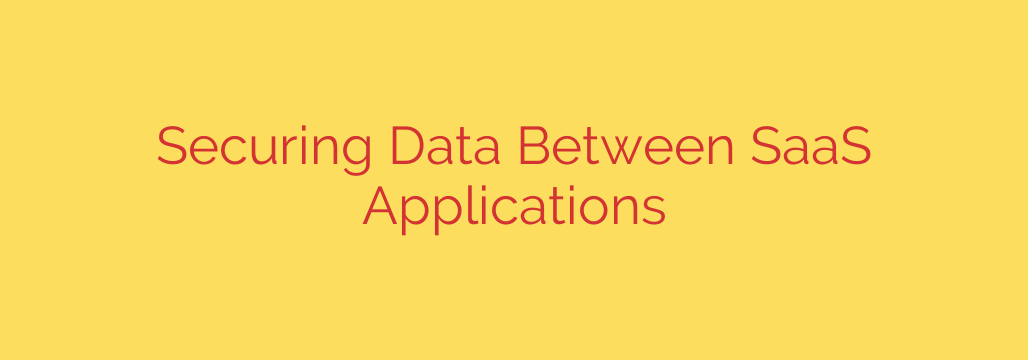
Protecting Your Digital Ecosystem: A Guide to Securing Data Between SaaS Applications
In today’s business environment, the use of multiple Software-as-a-Service (SaaS) applications is not just common—it’s essential for productivity. From communication platforms like Slack to CRM systems like Salesforce and marketing automation tools like HubSpot, modern companies run on a web of interconnected cloud services. While these integrations boost efficiency, they also create a new, often overlooked, security frontier: the data flowing between these applications.
Securing the connections between your SaaS platforms is a critical component of any modern cybersecurity strategy. A single weak link in this chain can expose sensitive customer data, intellectual property, and financial information, leading to devastating breaches and compliance violations.
The New Attack Surface: Understanding SaaS-to-SaaS Risk
The traditional security model of a protected internal network with a strong perimeter is obsolete. Today, your company’s data lives across dozens of third-party cloud environments. The real perimeter is now defined by the identity of your users and the permissions of your applications.
When you authorize one SaaS application to access data in another, you are essentially creating a digital doorway. Hackers know this, and they are increasingly targeting these integrations as a path of least resistance. A breach is no longer just about compromising a user’s password; it can involve exploiting an overly permissive API connection to siphon data from one trusted system to another.
The core challenge is that these connections often operate in the background with minimal IT oversight, creating a significant blind spot. Every integration you enable inherits the security risks of the vendor you are connecting to, effectively expanding your attack surface with each new app.
Common Vulnerabilities in SaaS Integrations
To protect your organization, you must first understand the primary ways these connections can be exploited. Most SaaS-to-SaaS security risks fall into a few key categories:
Over-Privileged Access: This is perhaps the most common and dangerous vulnerability. When integrating an application, it’s easy to grant it broad “admin-level” permissions out of convenience. However, an application that only needs to read contact names should never have the ability to delete entire databases. Applying the Principle of Least Privilege (PoLP)—granting only the absolute minimum permissions necessary for a task—is fundamental.
Insecure API Keys and Authentication Tokens: Integrations are typically authenticated using API keys or OAuth tokens. If these credentials are not properly managed, they can be leaked, stolen, or abused. Hardcoding keys in scripts, sharing them insecurely, or failing to rotate them regularly creates a permanent, non-expiring key for an attacker to exploit.
Lack of Visibility and Shadow IT: In many organizations, employees connect new SaaS apps without approval or knowledge from the IT department. This “Shadow IT” creates unsanctioned and unmonitored data flows. You cannot secure what you cannot see, and these hidden connections represent a massive, unmanaged risk.
Third-Party Vendor Risk: The security of your data is only as strong as the security of your SaaS vendors. A vulnerability in a third-party application you’ve integrated with can become a direct gateway into your own critical systems. Without proper vendor due diligence, you are placing immense trust in an external organization’s security posture.
An Actionable Strategy for SaaS-to-SaaS Security
Securing your interconnected SaaS ecosystem requires a proactive and continuous approach. It’s not a one-time setup but an ongoing process of management and monitoring. Here are essential steps every organization should take:
Discover and Map Your Entire SaaS Ecosystem: The first step is to gain complete visibility. Use automated tools or conduct a thorough audit to identify every application in use and, more importantly, every integration between them. Document what data is being shared, who authorized the connection, and why it’s needed.
Enforce the Principle of Least Privilege (PoLP): For every existing integration, review the permissions granted. Scrutinize scopes and access levels. If an application has “read/write/delete” access but only needs to “read,” immediately downgrade its permissions. Make this review a mandatory part of the approval process for any new integration.
Conduct Rigorous Vendor Due Diligence: Before integrating any new SaaS application, thoroughly vet its security practices. Look for security certifications like SOC 2 Type II or ISO 27001. Ask direct questions about their data encryption policies (both in transit and at rest), incident response plans, and how they secure their own API endpoints.
Implement Centralized Monitoring and Management: Relying on the native security settings within each individual app is inefficient and prone to error. Consider adopting a SaaS Security Posture Management (SSPM) platform. These tools provide a centralized dashboard to monitor permissions, detect risky configurations, and alert you to new, unauthorized integrations across your entire SaaS stack.
Secure and Rotate All Credentials: Treat API keys and OAuth tokens like the sensitive credentials they are. Store them securely in a vault, never hardcode them, and establish a policy for regular rotation. When an employee who authorized an integration leaves the company, ensure their associated tokens are immediately revoked.
By taking these steps, you can transform your web of SaaS applications from a potential liability into a secure, resilient, and powerful engine for your business. In an era defined by cloud collaboration, mastering SaaS-to-SaaS security is no longer optional—it’s a fundamental requirement for protecting your most valuable digital assets.
Source: https://blog.cloudflare.com/saas-to-saas-security/








